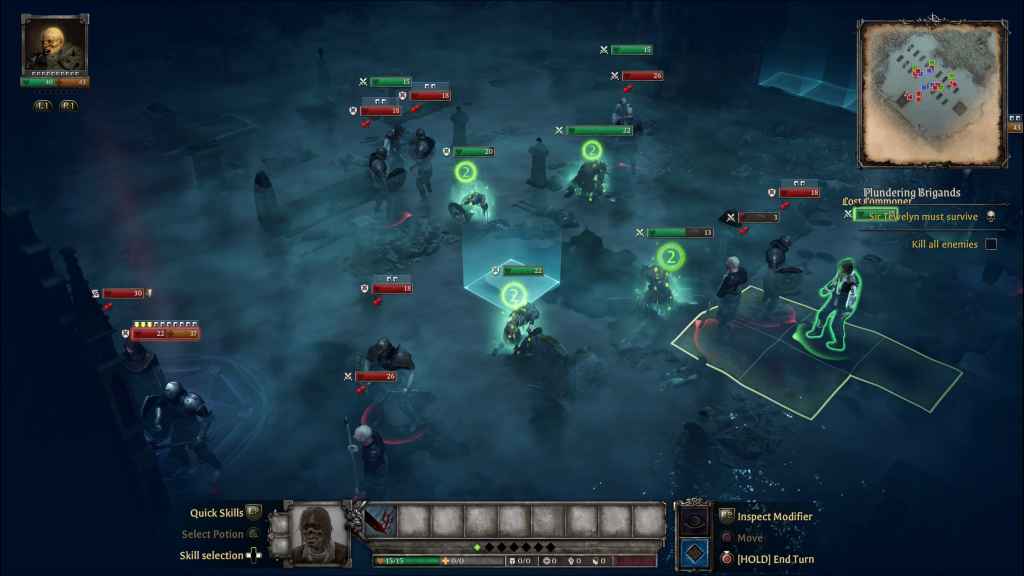King Arthur: Knight’s Tale PS5 Review – Channelling the classics of the tactical RPG genre, King Arthur: Knight’s Tale sets out to deliver on the ambitious task of making a layered and nuanced strategy game out of the world of King Arthur. King Arthur: Knight’s Tale largely succeeds in these promises while also being a fun enough strategy game in its own right while also being a lovingly transferred experience from PC to the PS5.
A heavy atmosphere and slightly tedious environments threaten to unsettle the experience but the foundation of the strategy is so strong that those seeking it out, will find it in spades.
King Arthur: Knight’s Tale Review (PS5) – Ambitious Arthurian Tactics
Beginning the Journey
King Arthur: Knight’s Tale follows the story of Mordred of King Arthur fame as he returns to life from death and is tasked with killing the now evil Arthur himself to save the land of Avalon from destruction. The premise is simple and gets to the point without delay, with a recap at the start of the game to introduce the key players and the core conflict.
The main story follows Mordred as he recruits various allies across the kingdom of Avalon to fight against King Arthur and it does little to become more complicated than that throughout the surprisingly long runtime of the main story. Some might long for a more twisting and turning narrative but I found that this simple premise allowed the characters to take centre stage, even if none of them are particularly complex in execution.
While not every character was a home run for me, with some particular weak links being excluded from my party almost immediately, there were equally characters that I grew to appreciate on the long journey to slay King Arthur. While player choice is somewhat influential to the overall game, and the characters that you will end up recruiting, these choices are generally without significant consequence to the main story, which lends a sense of focus that lets Mordred’s struggle really stay true to his character.
In doing so, there is an oppressive atmosphere that threatens to suffocate the game at points; this is a game that very rarely ventures into anything other than serious and melodramatic conflict. For some, that might be an exciting prospect, but I quickly found myself growing quite tired of overserious and heavy interpretations of my favourite characters from mythology.
Fighting the Long Fight
The majority of your time spent in King Arthur: Knight’s Tale will be spent in combat, which takes the form of a familiar top-down grid-based battle system in specific arenas. With a party of typically four selected members, most conflicts boil down to defeating and outmanoeuvring the enemy before they do the same to you with some light overworld traversal between these encounters.
The battle system rings very similar to other titles in the same genre but it works well in this context to allow for delicate strategies with satisfying rewards. Unit variety is plentiful and players are encouraged to experiment with new units as they appear thick and fast in the early hours of the game.
These generally fill the archetypes that come with the genre, with archers and mages preferring to avoid melee combat and sticking to further range, where armoured units can deal with the punishment of close-range combat. Everything works as you would expect it to and this knowledge is rewarded in earnest in other aspects of the game.
In a commitment to giving player’s the tools that they need to succeed, weapon accuracy is also not a factor in this title, with all attacks landing if you position well. Damage can fluctuate, lending that sense of risk, but archers are remarkably accurate in this world.
Despite having a relatively easy time adjusting to the control scheme of the game, I feel like an option for a quick undo option in the basic mode of the game would have been appreciated for the moments in which I wasted a move or my cursor was in the wrong position. While this did come down to me adjusting, the game does encourage experimentation in the basic difficulty setting and so I found this to be slightly frustrating.
The additional “Skirmish” mode allows for more crafted combat scenarios outside of the main campaign and these were fun breaks from the stress of having to micromanage my unit’s inventories and equipment with some unique traits. Skirmishes are ultimately more of the same though, and so only contribute to a sense of tedium that gradually begins to set in as I progressed through the game, compounded by the environments you traverse.
Stocking the Armoury
The second major portion of King Arthur: Knight’s Tale is spent in Castle Camelot, where management elements take the forefront and the true loop of the game begins to emerge. A key aspect of strategy in this game comes in the long-running consequences of your actions. Camelot functions as a home base for your growing army across the main story and is a long-running goal to restore it to its former glory.
By doing so, various facilities and resources open up and options for customisation begin to develop. These are valuable for your backup soldiers when they aren’t in your main party, with the training ground allowing them to maintain pace with your selected four units. Shops are also found here and allow for new equipment to be purchased. The other major facility is the hospice; in a choice that is bound to raise the stakes for higher difficulty play, damage is permanent to active party members.
While each party member has a yellow bar of “HP” that refills at the start of every battle, any damage beyond that small fraction damages their “vitality.” Damage to this bar is permanent and needs to be managed between battles. While it might be tempting to brute-force battles and not worry about health, King Arthur Knight’s Tale makes you consider the risk of letting units even take damage.
To restore this lost health and also treat any injuries that may negatively impact performance, units must be left in the hospice for a set number of battles until they are back in fighting condition. While you might be able to risk taking an injured unit into battle, death is permanent in whatever difficulty you choose (with limited exceptions).
This interplay between the turn-based combat and management strategy was a loop that I struggled to break out of and really enjoyed as the difficulty steadily increased, and so did the intensity of the choices I had to make.
Not forgetting (of course) the Round Table itself, there are a lot of moving aspects to the Camelot management system that had me experimenting for long periods between main missions.
A Game for Veterans
If there’s one thing that King Arthur: Knight’s Tale isn’t, it’s being beginner-friendly. While the game is far from the hardest I have ever played, I found myself butting heads with lots of mechanics that aren’t totally explained or complicated user interfaces that I had to navigate. This was particularly noteworthy in the customisation and optimisation of my units before combat.
Building well-balanced and well-equipped units comes largely down to understanding how this genre works beforehand and so I would hesitate to recommend the game on the aesthetics alone. While I do absolutely respect and appreciate the depth of the mechanics on display here, I feel like the tutorials offered by the game do little in terms of easing new players in.
This in conjunction with the heavy emphasis on mistakes having tangible consequences means that new players may be scared off before they’re given the proper opportunities to sink their teeth into the meat of the game.
King Arthur: Knight’s Tale succeeds in achieving the goals that it sets for itself but I rarely felt it go above and beyond the standards that I have become accustomed to over years of tactical game experience. The foundations of the game are refined and fun enough to experiment with but the oppressive atmosphere of the game makes long play sessions a slog and the game struggles to bring newcomers into the fold as a result. For veteran players seeking out a heavy and layered strategy game, this might be the one for you, where newcomers to the genre should look elsewhere.
King Arthur: Knight’s Tale is out for PS5 and Xbox Series X/S on February 22, 2024.
Review code kindly provided by publisher.





